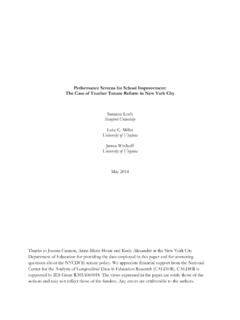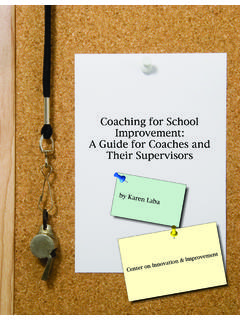Transcription of What is Effective Instructional Leadership? Longitudinal ...
1 What is Effective Instructional leadership ? Longitudinal evidence from Observations of Principals Jason A. Grissom Vanderbilt University Susanna Loeb Ben Master Stanford University ** Educational administration scholars have long argued that principals should serve as the Instructional leaders in their schools, but relatively few studies have attempted to link specific Instructional leadership behaviors in schools to school performance empirically. This study draws on in-person observations of principals collected over full school days over two different school years in a large, urban district to investigate how principals allocate their time across different Instructional leadership tasks, and how Instructional time use is associated with school effectiveness.
2 We find that overall Instructional time use does not predict school effectiveness, but that some specific Instructional activities do. In particular, time spent coaching teachers about their Instructional practice and evaluating teachers or curriculum predict greater school effectiveness and increases in school effectiveness. In contrast, time spent conducting brief classroom walkthroughs is associated with less Effective schools and decreases in school effectiveness. Negative associations are larger when principals report that classroom walkthroughs are not seen as professional development opportunities. ** Acknowledgements: This research was supported by a grant from the Institute of Education Sciences ( R305A100286 ).
3 We would like to thank the leadership of the Miami-Dade County Public Schools for all the help they have given us with both data collection and the interpretation of our findings. We are especially thankful to Gisela Field for making this work possible. We are also grateful to Mari Muraki for excellent data management and to Stephanie Andersen, Philip Balliet, Grace Karr, Victoria Sears, Sara Semelka, and the students at Stanford, Vanderbilt, and the University of Missouri who assisted with data collection. All errors are the responsibility of the authors. Preliminary Draft please do not cite 2 If there are two conclusions to be drawn from recent empirical research using comprehensive administrative data to examine principals effects on school performance, they are: (1) good principals raise student achievement (Branch, Martorell, & Rockoff, 2012; Dhuey & Smith, 2012; Grissom, Kalogrides, & Loeb, 2012), and (2) observable characteristics of principals (of the kind typically available in administrative data sets) explain little of the variation in principal performance once school -level factors are taken into account ( , Clark, Martorell, & Rockoff, 2009).
4 Instead, identifying the markers of what makes an Effective principal requires information about principals behaviors, skills, and other characteristics of their work. Research in educational administration suggests in particular that principals who focus their efforts on creating a school environment conducive to teaching and learning so-called Instructional leadership are most likely to facilitate school improvement (Robinson, Lloyd, & Rowe, 2008). Pinning down exactly what Effective principals do differently to build such an environment, however, remains a subject of debate (Murphy, 1988). Although different researchers emphasize different facets ( , monitoring classrooms, setting clear goals, protecting Instructional time), the thrust of this literature is that strong Instructional leaders are hands-on leaders, engaged with curriculum and instruction issues, unafraid to work directly with teachers, and often present in classrooms (Horng & Loeb, 2010, 66).
5 This latter idea, that good principals frequently visit classrooms in walkthroughs or informal evaluations, has become a particularly popular identifier of Instructional leadership (Eisner, 2002; Protheroe, 2009). Although the literature on Instructional leadership is extensive, most studies in this area like research on principal effectiveness more broadly are limited to small samples, or, in the case of larger-scale studies, rely exclusively on surveys to draw inferences about principal Preliminary Draft please do not cite 3 behaviors and skills. Small samples constrain researchers from linking principal behaviors empirically to school outcomes and raise concerns about generalizability.
6 Survey data can help circumvent these problems, but possibly at the expense of depth and come with their own set of potential problems, including unreliable respondent recall or social desirability bias, which may introduce measurement error and other challenges. Moreover, studies linking principals Instructional leadership behaviors to student outcomes using larger samples have rarely utilized Longitudinal student-level administrative data capable of appropriately controlling for other predictors of student learning. At least one recent study of principal effectiveness using a student-level value-added framework found evidence that other factors, such as skills related to organizational management, were more important than Instructional leadership skills in explaining student performance (Grissom & Loeb, 2011).
7 This study employs a different approach to the study of Instructional leadership , leveraging a unique alternative source of data about school leadership behaviors: in-person observations. Over two different school years (2008 and 2011), we sent trained observers into a stratified random sample of approximately 100 schools in Miami-Dade County Public Schools (M-DCPS), the nation s fourth-largest school district, to shadow school administrators over full school days and record detailed information about principal time allocation. Pairing the detailed data collected by the observers with rich administrative data provided to us by the district, which includes information about schools, personnel, and students, and with survey data collected from the principals, we investigate principals investment in Instructional leadership behaviors in their schools.
8 Moving beyond just examining time spent on instruction broadly, we examine how principals spend time on specific task areas related to leading their school s Instructional program, differentiating, for example, time spent monitoring teachers from Preliminary Draft please do not cite 4 time spent on other kinds of instruction-related tasks, such as providing teachers with feedback or developing the educational program at the school . We then explore whether time spent on different Instructional activities is associated with different school characteristics. Finally, we investigate whether variation in overall or specific Instructional activities predict either schools value added performance or increases in schools value added performance over time.
9 We find that overall Instructional time use does not predict school effectiveness, but that some specific Instructional activities do. In particular, time spent coaching teachers about their Instructional practice or evaluating teachers or curriculum predict greater school effectiveness and increases in school effectiveness. In contrast, time spent conducting brief classroom walkthroughs is associated with less Effective schools and decreases in school effectiveness. Negative associations are larger when principals report that classroom walkthroughs are not seen as professional development opportunities. Effective Principals as Instructional Leaders Research linking high-quality school leadership to better school performance has a sustained history in educational administration (see Hallinger & Heck, 1998).
10 More recently, several studies leveraging rich panel data on student outcomes have demonstrated this linkage as well (Branch, Hanushek, & Rivkin, 2012; Coelli & Green, 2012; Dhuey and Smith, 2012; Grissom, Kalogrides, & Loeb, 2012). For example, Branch, Hanushek, and Rivkin (2012) estimate that a school with a principal whose effectiveness is one standard deviation above the mean will have student learning gains at standard deviations greater than average smaller than the typical effect size for teacher quality, unsurprisingly, but still educationally important, especially given that principal effects apply to every student in the school .














